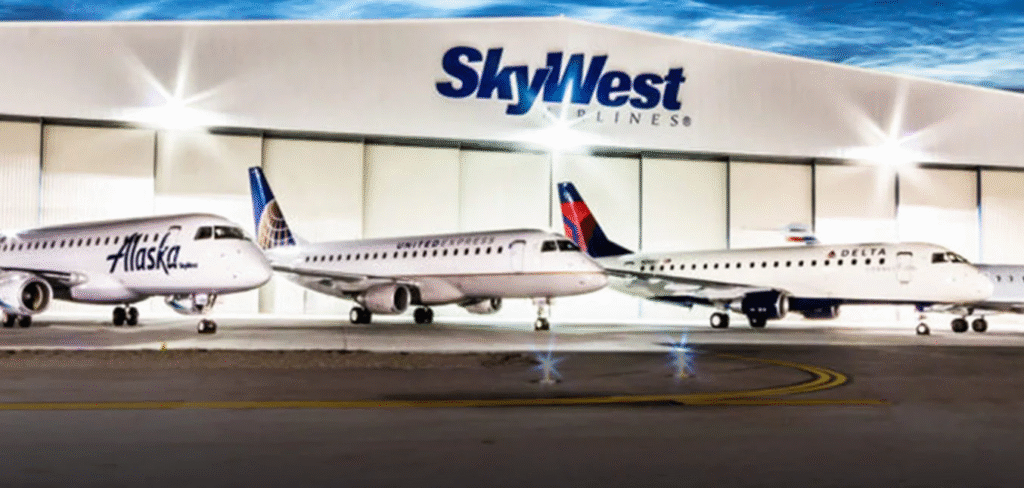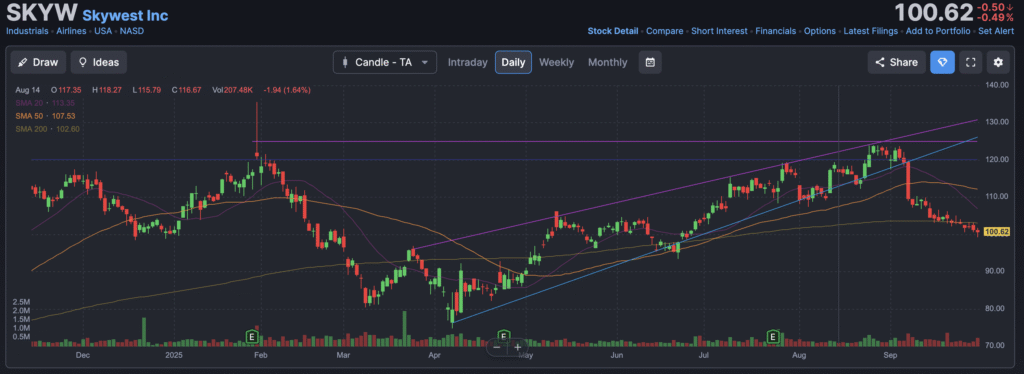SkyWest, Inc. (NASDAQ: SKYW) is a leading regional airline operator in North America, founded in 1972 and headquartered in St. George, Utah. The company primarily operates flights under capacity purchase agreements (CPAs) with major airlines including Delta Air Lines, United Airlines, American Airlines, and Alaska Airlines. In 2024, SkyWest generated revenues of approximately $3.1 billion, reflecting steady growth from increased demand for regional travel and a post-pandemic recovery. The company operates a fleet of more than 500 aircraft and flies to over 240 destinations across the U.S., Canada, and Mexico. Its top competitors include Republic Airways, Mesa Airlines, and Envoy Air, which also serve as key regional feeder airlines for major carriers.

Recent Earnings Performance
On July 25, 2025, SkyWest reported its second quarter 2025 earnings. The company posted earnings per share (EPS) of $2.05, which came in above analyst consensus of $1.88, while revenue reached $820 million, up 5% year-over-year. The performance was supported by higher block hour production and improved aircraft utilization despite ongoing pilot hiring challenges. Management provided guidance for the third quarter with EPS expected in the $1.90–$2.10 range, and reaffirmed full-year 2025 revenue guidance of about $3.2–$3.3 billion, reflecting stable demand. The company also reiterated its expectation of continued capacity constraints due to pilot availability but anticipated steady improvement into 2026.
Founding, Evolution, and Business Model
SkyWest was founded in 1972 by Ralph Atkin as a small commuter airline in St. George, Utah, initially flying a single aircraft to Salt Lake City. The airline quickly grew by focusing on underserved markets and developing partnerships with larger carriers. By the 1980s, it had entered into codeshare agreements with major airlines, a move that would define its long-term business model. The company completed its IPO in 1986 and continued expanding through acquisitions, including the 2005 purchase of Atlantic Southeast Airlines (ASA), which strengthened its presence in the eastern U.S. Today, SkyWest operates almost entirely under CPAs, where it is paid a fixed fee by partner airlines regardless of ticket sales, giving it predictable revenue streams.
SkyWest’s business model centers on being the outsourced regional flying arm for major U.S. carriers. Unlike traditional airlines that face yield and demand volatility, SkyWest generates revenues through contracts that cover costs plus margins. This allows it to operate profitably in good times and downturns, though it also limits upside during periods of strong demand. The airline industry’s consolidation has further cemented SkyWest’s role, as Delta, United, American, and Alaska prefer to outsource regional operations instead of operating them internally.
The company’s funding history is tied to both public capital markets and aircraft financing arrangements, given the capital-intensive nature of the airline industry. SkyWest typically acquires new aircraft through leasing or structured debt transactions, aligning fleet expansion with partner needs. Key competitors include Republic Airways and Envoy Air, both of which also have CPA-based models. The company’s headquarters remains in St. George, Utah, symbolizing its roots as a regional operator that scaled into one of the largest players in its niche.
Market and Growth Outlook
SkyWest operates in the U.S. regional airline market, a segment of the broader commercial aviation industry. The market is estimated at roughly $18–20 billion annually and is expected to expand steadily as major carriers continue outsourcing regional routes. Growth is driven by demand for connectivity between smaller cities and larger hubs, as well as the replacement of aging 50-seat regional jets with newer, more efficient 70–76 seat aircraft.
By 2030, the U.S. regional airline market is projected to grow at a compound annual growth rate (CAGR) of around 3–4%, in line with broader domestic passenger growth. While not a high-growth sector, it remains essential to the airline ecosystem, particularly in the post-pandemic environment where travelers increasingly rely on smaller city access. Capacity constraints, particularly pilot shortages, remain a limiting factor but also act as a barrier to entry for new competitors.
Competitive Landscape
SkyWest competes against Republic Airways, Envoy Air (a subsidiary of American Airlines Group), and Mesa Airlines. Republic is the largest independent competitor, operating significant fleets for both Delta and United, while Envoy Air benefits from being wholly owned by American Airlines. Mesa has historically struggled with profitability and contract disputes, making it less stable than SkyWest or Republic.
SkyWest differentiates itself with scale, operational reliability, and diversified contracts across four major carriers, reducing dependence on any single partner. In contrast, competitors tend to be more concentrated with one airline, leaving them more exposed to strategic changes by partners.
Unique Differentiation
SkyWest’s differentiation lies in its scale, strong relationships with multiple major carriers, and a track record of operational efficiency. The company’s ability to manage one of the largest regional fleets in the world allows it to maintain favorable negotiating leverage with aircraft lessors and manufacturers. Its diversification across Delta, United, American, and Alaska also makes it more resilient than peers that rely heavily on a single contract. This breadth provides both stability and flexibility to adjust capacity when carriers restructure networks.
Management Overview
Chip Childs has served as President and CEO since 2016, after previously holding leadership positions within the company. He has focused on expanding SkyWest’s fleet modernization program and strengthening CPA relationships. Robert Simmons, CFO since 2014, oversees the company’s financial strategy, including aircraft financing and capital structure management. Wade Steel, Chief Commercial Officer, plays a key role in negotiating contracts and managing carrier relationships, ensuring SkyWest remains the preferred partner for its airline customers.
Financial Performance Over the Last Five Years
From 2020 through 2024, SkyWest’s revenue experienced significant swings due to the pandemic but demonstrated resilience under the CPA model. Revenues fell sharply in 2020 but recovered to $3.1 billion in 2024, reflecting a five-year CAGR of about 2%. The company’s earnings, while pressured during the pandemic, rebounded strongly with net income margins averaging 8–10% in recent years. EPS grew from a low of negative territory in 2020 to over $6 per share by 2024, translating into a strong recovery CAGR.
The balance sheet has remained stable, with SkyWest maintaining moderate leverage despite its capital-intensive business. Debt peaked during the pandemic as the company secured liquidity, but has since declined steadily as cash flows normalized. Liquidity is supported by cash reserves and undrawn credit facilities, giving it flexibility to weather industry cycles.
Bull Case for the Stock
The bull case for SkyWest is centered on stable CPA-driven revenue streams, strong recovery in air travel demand, and long-term fleet modernization. Its diversified carrier relationships reduce counterparty risk, while efficiency improvements position it as the lowest-cost operator among regional airlines.
Bear Case for the Stock
The bear case highlights pilot shortages, dependence on major carriers for contract renewals, and modest long-term growth compared to other aviation segments. The company’s upside is capped by fixed-fee agreements, limiting benefit from surging travel demand. Additionally, regional flying faces structural risks from potential route rationalizations as airlines focus on hub efficiency.

The stock is in a stage 4 decline on the monthly chart and has support in the $97 range where it currently is, but is likely to test the new lows in the $91 range before we watch for a reversal. The daily chart is in the stage 4 decline and has multiple support areas in the $93 – $95 range.